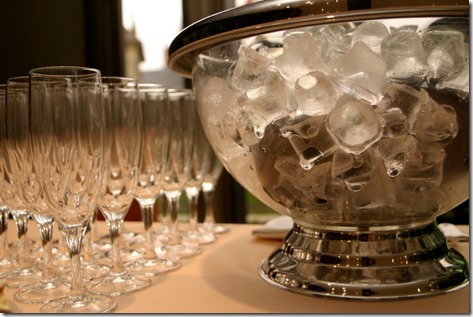Public Speaking Horror Story: You're Catering Now?!?
A few years ago, I was hired to give a keynote speech to a group of about 100 PR professionals.
I wanted to make this presentation special—completely tailored to this group—and spent a lot of time preparing a personal keynote.
The open I created felt particularly strong. I practiced it several times until I got the timing and wording just right. I was confident that the open would not only get a laugh, but that it would set the stage for the entire talk by establishing a theme I planned to return to numerous times. This was a sure winner, and I couldn’t wait to deliver it.
On the morning of the keynote, I waited a few extra minutes before beginning so the latecomers could find their seats without disrupting my open. When everyone appeared to be seated, I signaled to my host that he should begin his introduction of me.
He introduced me, I strode to the center of the room, and I opened my talk.
I was about one minute into the open when the doors to the room swung open. In walked four members of the catering team, who proceeded to refresh the drink and snack stations quite noisily. As they slammed ice into the ice chest and set the coffee station, the entire audience turned toward the loud disruption. The noise continued for what felt like a lifetime (but what was probably about a minute).
To prevent any awkwardness, I decided to continue speaking—but the interruption stole the audience’s attention and broke my flow. The open’s punch line landed with less impact than it should have, and my critical moment to establish the presentation’s framework was, at least partially, diminished.
In hindsight, there are a few things I could have done differently.
1. Speak to the host and catering manager in advance
It would have been perfectly appropriate to ask to speak with the catering manager when I arrived to the speaking venue. I could have asked the manager when they planned to refresh service and to come up with a mutually convenient moment to do so (preferably before or after my presentation).
2. Ask the catering staff to come back later
The moment I realized that the catering crew was going to create a noisy disturbance, I could have asked them to return later. The key would be to make sure my tone toward the crew wasn’t even remotely rude; any whiff of condescension would have made everyone in the room uncomfortable. Rather, I’d have to make sure my tone came across as apologetic and kind (“Pardon me. I’m sorry to ask you to do this, but we’re just getting started here. Would it be possible to please come back during our first break in about an hour? Thank you so much.”)
3. Hit the pause button
This is my least favorite option of the three, but it might still have been better than trying to speak over the din. I could have said, “I want to make sure you’re all able to hear without distraction, so why don’t we give the catering crew a few moments to do their work, and then I’ll resume?”
This is “public speaking horror story week.” What speaking horror stories have you faced? Please leave your experiences and lessons learned in the comments section below.

The event managers (venue and conference) are at fault here. They should have discussed when ANY service during programming would take place to ensure that NO speaker or activity was interrupted.
The best thing at the time would’ve been option 2, with a word to both event managers afterward about how unprofessional it was to schedule something so obviously disruptive during a presentation.
I actually prefer #3 because (I’ll assume) the catering staff was behind schedule already — it appears they didn’t have the room set up in advance as they should… and wanted to ensure refreshments were available to attendees throughout the presentation. However, If I were in Brad’s shoes and chose #3 I probably would have needed to expend considerable energy to keep myself from seething. Perhaps having some rather light banter/anecdote in my hip pocket (in the same vein as the emergency prep that Brad wrote about in the panelist scenario higher on his list of stories) could bridge the awkwardness of the catering interruption. Once the clatter ended, make it clear we were moving on to the heart of the presentation and begin going forth to do good things.
Jeff,
Thanks very much for your comment, and for your astute observation about one’s desire to seethe in such situations. Whenever I’m in front of an audience and feel like seething inside, I force myself to react in an almost naive manner. That way, people aren’t sure whether I’m really nice or whether I simply don’t see that there’s a problem (I usually do). But that way, no one looks bad in the situation – not me, nor the people who are perhaps deserving of my anger.
I suppose you can never lose points by exhibiting grace in a tough situation.
Thanks for reading,
Brad
Of course, No. 1 is the best option. However, #3 is the second best option. Sure, you could stop the catering crew and get them to come back later. But then, all the people wanting water, coffee, or tea, now!, are sitting there thinking, why did he send them away?
Pat,
I hadn’t thought about that – good point. I’d feel okay about sending the caterers away for shorter sessions – they shouldn’t be getting up to refresh their drinks during a half-hour talk – but agree with you that people want their drinks and chips in longer ones.
Thanks for commenting!
Brad